Eat This While You Read That: Toni Weisskopf
Toni sent me this, along with a book recommendation, and of course I was going to use it. Her buckeyes are fantastic, and plentiful (if, like me, you're planning a smaller Christmas in 2020, you can reduce the size to a quarter of the recipe and still get great results. This is a wonderful primer on the making of these traditional Holiday treats. Enjoy!
From Toni Weisskopf:

Reading suggestion: The Miracle on 34th Street. Is it fantasy? Fantasy is in the eye of the beholder…. The only possible fannish connection I can think of is that it depicts a successful write-in campaign, and might possibly have inspired the fans of Star Trek decades later in their successful bid to save the show.
I have long shared this popular recipe for the homemade peanut butter and chocolate bonbons that I make every year. And here’s the basic recipe. Below, you’ll find, as Paul Harvey says… the rest of the story.
Christmas Buckeyes
Makes 150-180 balls, give or take.
Insides:
1 tsp. vanilla
1 pound butter, softened
2 pounds creamy pb—use Skippy
3 pounds powdered sugar
Mix above ingredients thoroughly until mixture is uniform. Can use a heavy duty mixer, but dough will be very stiff, so probably will need to end with hands. It will take a while. Roll into small balls, about cocktail meatball size, and place on wax or parchment paper to await dipping.
Dip in:
12 oz. Nestles semi-sweet chocolate chips + 1/2 bar paraffin (yes, this is just wax—you’ll find it in stores that have canning supplies or larger grocery stores)
* or *
a couple of packages of chocolate bark (option I’ve used in the past few years and nobody seems to object; found in baking section of store)
Over a double boiler, melt chocolate. (My double boiler is a regular pot with a metal mixing bowl plopped over it.) Once water is boiling, lower heat so a gentle steam is maintained so chocolate stays melted while you are dipping.
Taking a wooden toothpick (plastic ones okay, but buckeyes slip off more easily on them), inserted about 1/3 to 1/2 way into the ball, dip into chocolate and swirl around, coating most of the ball, but leaving the top open. (Hence “buckeye”: they look like chestnuts called “buckeyes.” Ohio is the “Buckeye” State, btw, which is why Ohio State’s football team is nicknamed “Buckeyes.” You’re welcome.) Place on waxed cookie sheet. Let sit until chocolate is set. Store in tightly covered container. Will last weeks. If you don’t eat them. Can be frozen.
Advanced Buckeye Primer Notes
Phase 0: Gathering supplies.
Since peanut butter keeps so well, you can look for sales throughout the year. Same for chocolate bark and confectioners sugar. Even butter—butter keeps fine in the freezer. Use the expensive real vanilla extract, though, none of that artificial crap. On the chocolate, we’ve tried it all. This year I used a mix of Food Lion generic bark, and fancy Amazon ordered melting chips. Came out pretty milk chocolatey. Next year I’ll mix something darker in, I think.
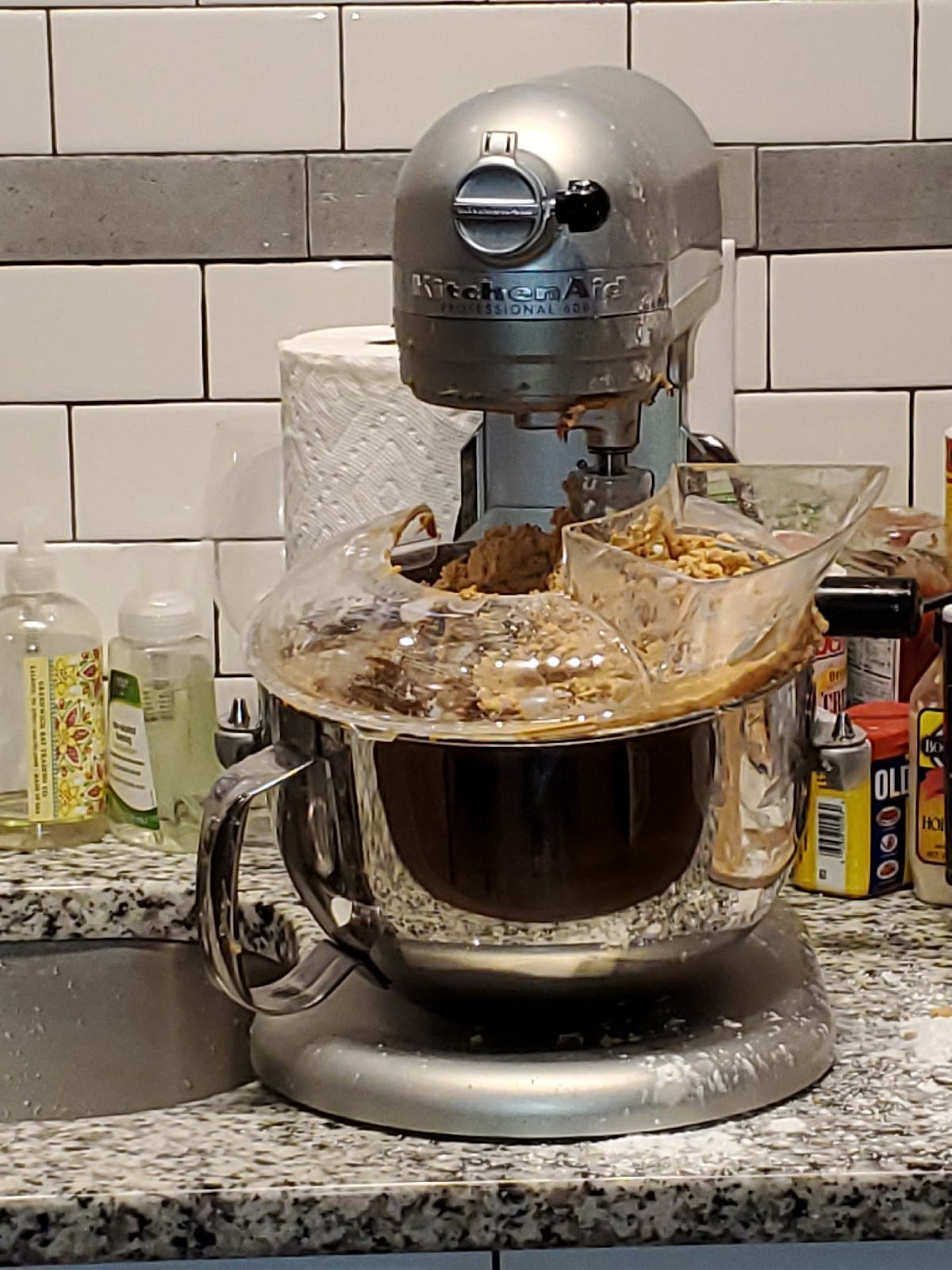
Cooking supplies:
* Heavy Duty Kitchen Aid mixer with spill cover. (You can make these by hand and I did so for many years. But if you’re making more than one batch, that gets tedious.)
* Wooden toothpicks, lots (see below)
* Scale to weigh out ingredients. Ratios are not fragile, but there is a platonic ideal of buckeye innard girth and innard to chocolate ratio, so texture and size do matter.
* At least two XL metal mixing bowls (porcelain will just be too darn heavy with all the dough in there), plastic won’t stand up to it
* At least 2 small metal mixing bowls to put over your 2 large pots for melting chocolate in you are working with a partner
* 2 silicone spatulas with wooden handles to stir melting chocolate to uniformity
* 2 washable pot holders to adjust chocolate bowls as necessary—and they will get coated with chocolate
* At least one box of wax paper to lay ball innards out on your at least 6’ long table, more for packing. And may I say that the new Cut-Rite wax paper sucks? It’s too thin, the grease seeps through and it’s not stiff enough to handle moving stuff around. Rips too easily when packing, too. Bah, humbug, why must things change for the worse? Moving on.
* Festive metal tins to use as giveaway packages. Can be had for relatively cheap new at Big Lots starting in November, but you can also find used even cheaper at yard sales. People never give the small ones back. You’ll need more than you think.
* Scissors (to cut wax paper)
* 2 or more flat cookie sheets—the completely flat kind, not the ones that are actually good for baking cookies with the air pocket—because it’s easy to slip these under the naked balls for transport to the dipping stations. 4 is best even if working alone, so the balls have time to set up before you remove them.
Phase 1: The mixing.
Order doesn’t really matter in the end, but may be easier if you go: pb, butter, vanilla, about a quarter of the sugar to start, and gradually pour in the rest. Takes about half an hour for 2 batches. Start slow or the poof of confectioners sugar will coat everything—well, worse than it would otherwise. Realistically, there will be confectioners sugar everywhere anyway.
Helpful dog, who does not have a white streak of fur on her ear, but of confectioners sugar:

Phase 2: The balling.
This takes approximately until the heat death of the universe. I exaggerate. But around ball 200 you may experience the epiphany known as the Miracle of the Balls, when although you have been balling forever, the mixture in your bowl has not gone down at all. May also be influenced by what sort of pain killer you have taken to shut your lower back up from complaining about standing and bending over a table rubbing your hands together endlessly, especially if you’ve made rum and bourbon balls in the same day as the buckeyes. The temptation will be to start making bigger balls. Resist. As in so many things, there is a too big, and there is a too small. Also note you will want a firm, smooth ball, but not a smushed one.
Innards on parade:
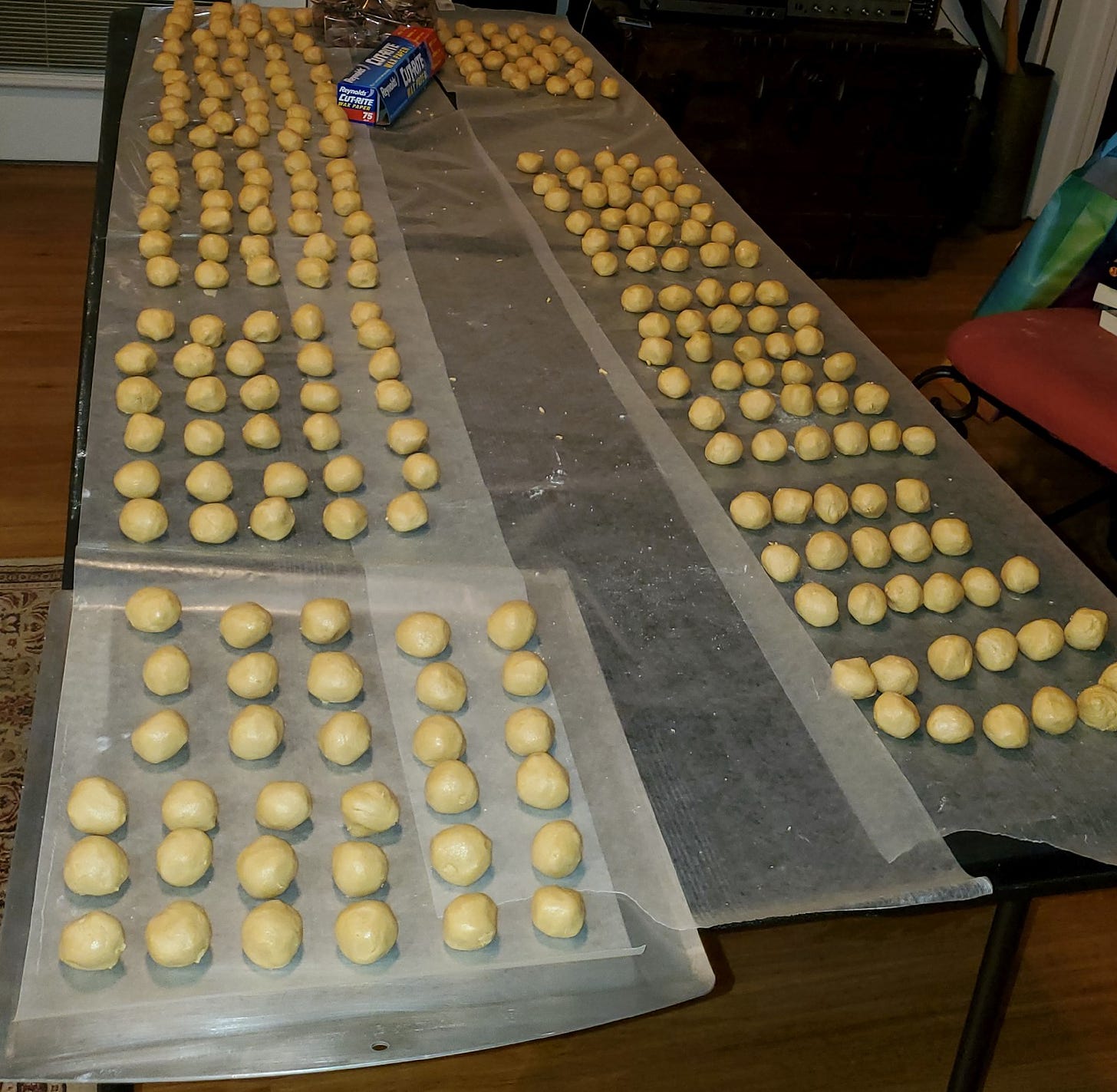
Phase 3: The dipping.
Recall, balls have an affinity for disco (I don’t make the rules, I’m just reporting them)—you will need something to power through this phase. Slide the cookie sheets under the wax paper your balls are lying on—a 5 x 6 grid of ball works on most cookie sheets. There may be chocolate trails from double boiler bowl to cookie sheet, so a protective covering of wax paper may be handy here—but make sure not too close to your heat source. The double boiler should neither be too hot, nor too cold. Bring to a roiling boil, then turn down to a simmer. Too hot and the chocolate will be too drippy and return a thin coating. Too cold and the chocolate won’t melt and you’ll get icky lumps. Filleth not the chocolate bowl too high, nor yet too low. Say about 85% full. How much you use depends on the size of the bowl, but in general about one or two packages of bark at a time. You’ll need to refill when it gets too low, generally after two sheets dipped, and stir every now and then as it melts.
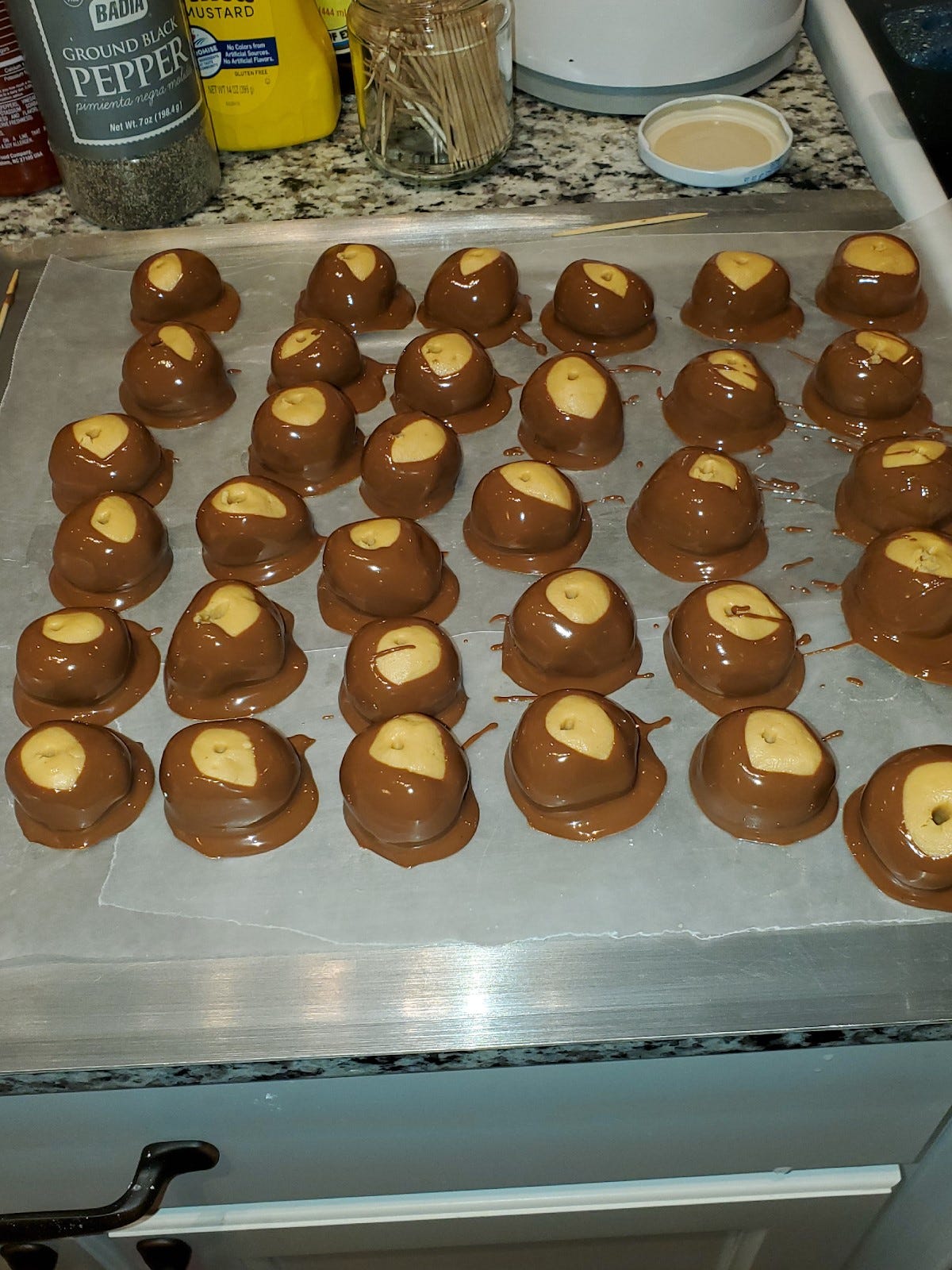
In the acting of dipping, be firm and decisive. Make no more than 4 passes in the chocolate to get the desired “eye” of the buckeye and know where on the sheet you’re going to return the ball. Dip at the edge of the bowl rather than the center. Take too long and you’ll lose the ball in the chocolate and have to fish it out and compromise the smoothness of the coating. Also, you’ll burn yourself on the hot bowl, but really, what’s a little burn for the sake of buckeye integrity? Watch also for chocolate dripping down the toothpick to create an unsightly black eye in the buckeye. Some people can use one or maybe two toothpicks all night (we’ll call them “Julies”). Some need many more (those are your “Tonis”). No judgment. Return dipped balls to sheet, and when sheet is full, slip back onto the table, let them set up for a few minutes, then carefully slide cookie sheet out from under the wax paper and move to the next grid. Takes about an hour per batch to get them all done from start of double boiler to last ball dipped. You’ll want to let them sit and harden for at least a few hours, and overnight is good. PROTECT FROM YOUR PETS. (You, of course, did not use a pb that is deadly to pets, and yet still, they get other things for Christmas, and you know they’re too fat anyway.)
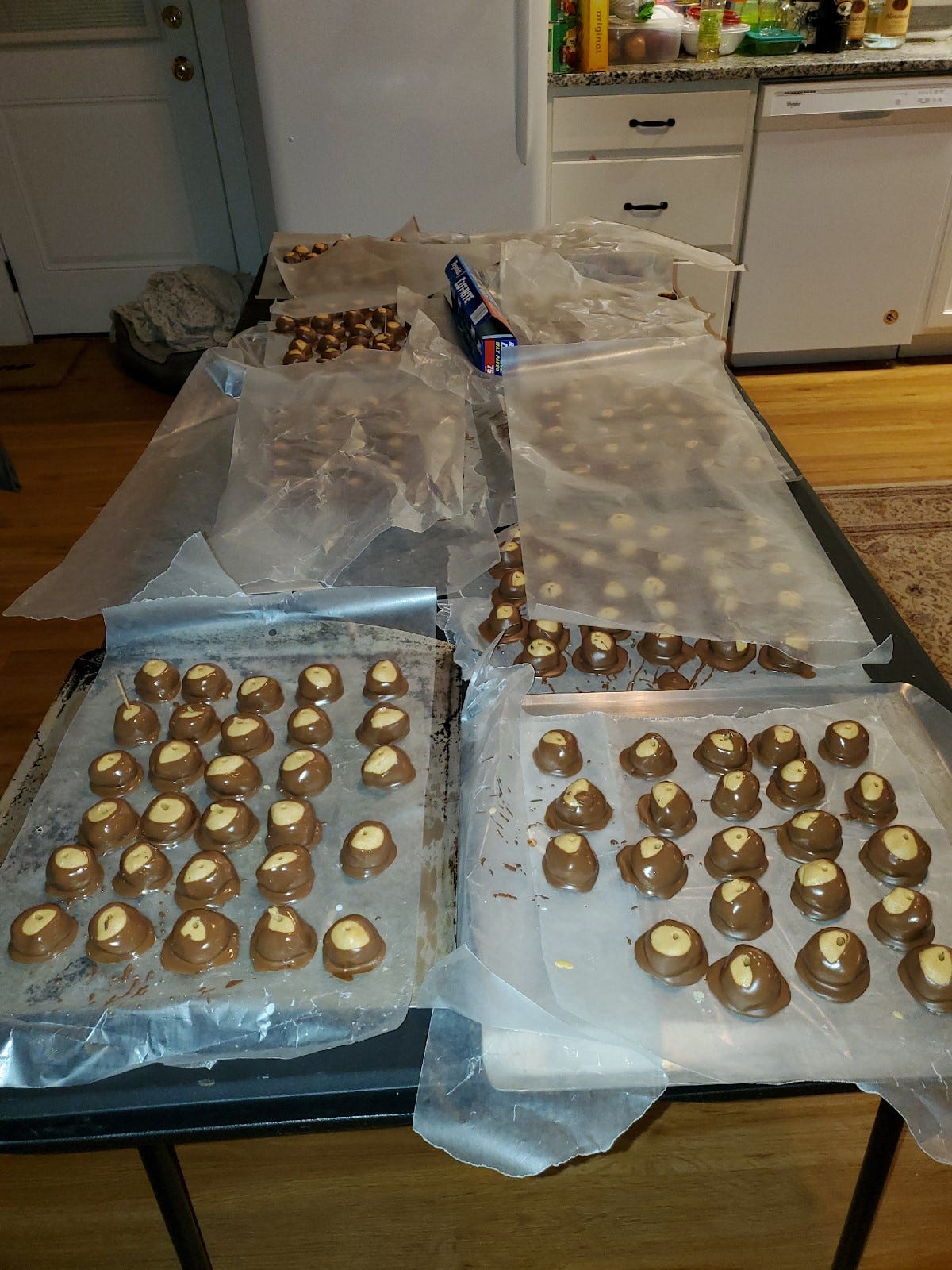
No matter what you do, there will be leftover melted chocolate. You can freeze this for later use, bowl and all, or, if you have room, scatter some salted nuts on wax paper and pour over to make a nice chocolate bark.
Phase 4: The packing.
Especially with this cheap-ass wax paper, the balls might stick. Do not yank from above, gently displace from below. Place wax (or carefully measured circles or squares of parchment paper) into your tins, and place buckeyes into tins, leaving a bit of space around each one. They are structurally sound enough you can do 2 or even 3 layers if you spread the weight around, and put wax paper between each layer. Once the tin is full fold the wax paper over the top, crumpling a little to make sure the balls don’t move around. The larger, perhaps less visually appealing ones, are your natural bottom layers. The smaller, more attractive ones go on top. They all taste good (and are about 75 calories each). Seal and share with holiday abandon.
Two on the left are for quality taste tests and the two on the right are good bottom layers:
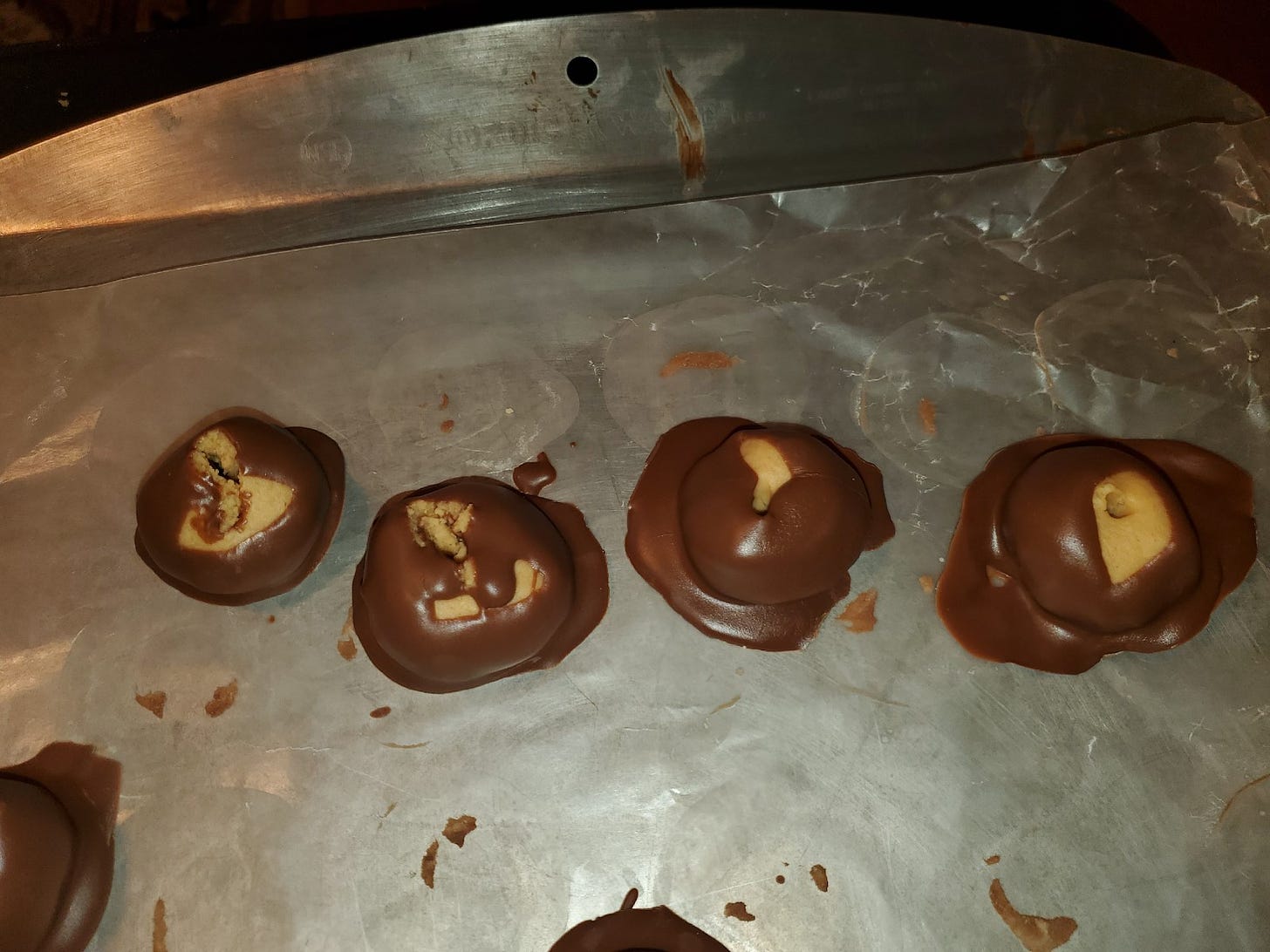
The beau ideal of buckeyes:

Photos provided by Toni Weisskopf




